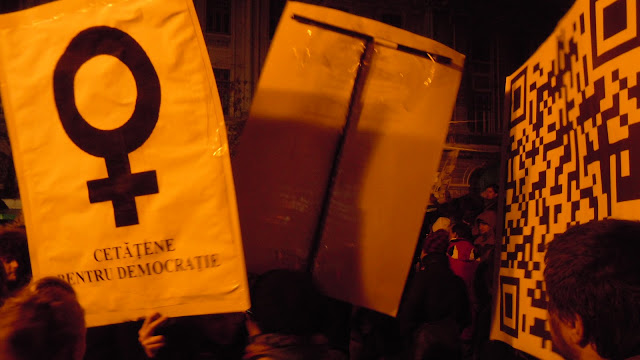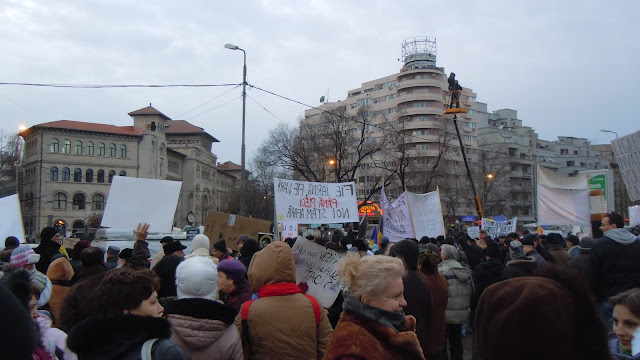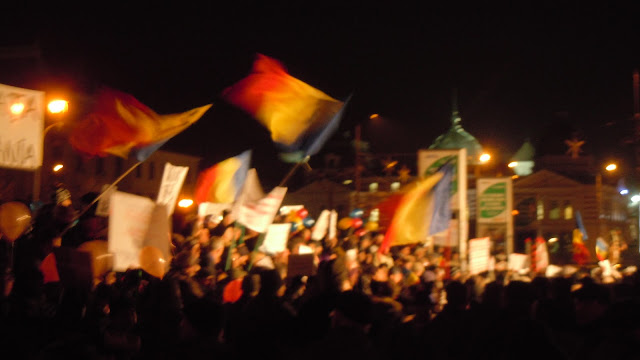of all the necessities, the most human one is the necessity of a purpose
20120126
Bucharest in photos. The city by night
Winter is finally here (and protests go on, attended by ~ 100 people, as far as I could see it), but my mind goes back.
Picture taken five years ago, on January 9th, 2007.
20120123
20120121
20120120
20120119
Protests in Bucharest. My view
After 4 days of taking contact with Piata Universitatii, I think I have an opinion about the events and I can let you know about it.
I saw different kinds of people in Piata Universitatii: 1. people politically involved (former revolutionaries and members of the Social-Liberal Union); 2. hooligans; 3. (most important) people who are really unsatisfied with the way things go. To those, I add a fourth category: 4. spectators, people who preferred watching events live, and not on a television screen. In my view, this category is the most numerous, but the less important.
Violence is not the issue in these protests. What happened on Sunday night was just another episode of the confrontation between football hooligans and gendarmes (observation: I noticed every time groups trying to incite to violence). But the hyper-mediatization of the events was also a reason for violence: the omnipresence of mass-media excites the hundreds of people who protest in the square and I witnessed that. This can also explain the paradox that violent protests were only in Bucharest (while people protest in tens of Romanian cities), even if the average income here is much higher than in the rest of the country. Normally I would expect people really hit by austerity and crisis to have a harsher reaction, but it was the other way around.
An observation about figures. There are not many people protesting in Piata Universitatii. Generally their number was less than 1,000, now they are about 2,000. For comparison, tens of thousands of people are the rule in important religious celebrations, aproximatelly 40,000 would go to a match between Steaua and Dinamo and 60,000 people attended the concert of Madonna in Bucharest. So, I would say society is not fully focused on these protests, and I would say that is because many people see these protests as nothing more than political combat - credit goes to the media for that.
What is happening in Piata Universitatii is not (or not intended by most of the active protesters) partisan combat. There are a few hundreds of people who remembered that, before being voters to a party or another, they are citizens, ignored by politicians, and they remembered that they profoundly dislike the Romanian political class, mostly because of its arrogance. The entire Romanian political class, not only the government party, because the entire Romanian political class is a result of the National Salvation Front (thus, indirectly, a result of the Communist party). In my view, what protesters try to do there is to carry on the spirit of Piata Universitatii of 1990 and 1991. And the key of the protests is this: will protesters be able to ask for a de-Communization act ("legea lustratiei")?
The reaction of the politicians is predictable and, in my view, simply disastrous. The governing democrat-liberals hope these events will vanish quickly, as the protests are the result of an unhappy decision of the government party to change the health act without consulting the society, and they are frozen silent. The socialist-liberal opposition acted just like the former FSN: members of the opposition parties tried to infiltrate the protests, they mainly failed, so the opposition organized today, elsewhere in Bucharest, a manifestation attended by 7,000 political supporters brought from the entire country, attempting to steal the attention of the society and to change the essence of the protests, by transforming them into a partisan fight. In my view, they failed in this attempt too.
My conclusions:
1. There is a huge lack of communication between the society and the political class. The actual Romanian political class cannot save itself anymore. It is too late for that now.
2. The Romanian political class is definitely and completely compromised and illegitimate.
3. The tension in the society is high. Even if people do not protest, people in Romania watch the events and care about what is happening.
4. The protests in Piata Universitatii are not approved legally and there is no institution cautioning them. Protesters express their dissatisfaction and their desperation, but most of them do not know what should be done. They want to replace the government, but they do not know whom to vote for, as the opposition is out of question.
Simply put, the message of (most of) the protesters in Piata Universitatii towards the Romanian political class is: You ignored us. We have enough. Stop and leave.
Kindle your mind,
Subscribe to:
Posts (Atom)








































































